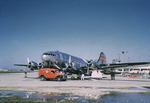C-75 Stratoliner
| Country | United States |
| Manufacturer | The Boeing Company |
| Primary Role | Transport |
| Maiden Flight | 31 December 1938 |
Contributor: David Stubblebine
ww2dbaseThe Boeing C-75 was a long-range transport aircraft introduced to military service in February 1942. They were used by the USAAF's Air Transport Command until 1944 and pioneered transatlantic air travel by a commercial landplane.
ww2dbaseThe C-75 was a modified Boeing 307 airliner, which was itself based on the B-17C airframe. Compared with the B-17, the 307 had a larger diameter fuselage and with its maiden flight in 1938, it became the first production liner to have a pressurized cabin. This early work with cabin pressurization helped Boeing develop the B-29 Superfortress and put it into the air as early as September 1942.
ww2dbaseBefore WWII ended their production, ten Boeing 307 Stratoliners were built. TWA bought five and flew domestic routes between New York and Los Angeles for 18 months until the Army purchased them shortly after the Japanese attack on Pearl Harbor. The five TWA Stratoliners were converted for military service in January 1942. TWA's Intercontinental Division then operated these C-75's under contract to the Army's Air Transport Command until July 1944.
ww2dbaseAt the time, the C-75 was the only commercial landplane capable of crossing the Atlantic with a significant payload until November 1942 and the arrival of the Douglas C-54 Skymaster (DC-4). The C-75 had two main transatlantic routes: Washington, DC to Cairo across the South Atlantic; and New York to Scotland across the North Atlantic. They often flew non-stop the 2,125 statute miles (3,415 km) between Gander, Newfoundland and Prestwick, Scotland in the north, and the 2,550 statute miles (4,100 km) between Natal, Brazil and Accra, Ghana in the south. These were very long flights for the time. After July 1942, a refueling stop at Ascension Island was an option in the south. In the north, stops at Iceland or Greenland were often necessary, especially flying westbound against the prevailing winds. As C-54's took over the Gander to Prestwick route, the C-75's operated a Marrakech to Prestwick service out over the Atlantic. Before the C-75's were returned to their private owners, they completed some 3,000 ocean crossings and logged more than 45,000 hours in flying to every corner of the world.
ww2dbaseBefore the war when TWA operated the five Boeing 307's as passenger liners, they assigned them names corresponding with Native American tribes. When those aircraft entered USAAF service, each plane retained its tribal name and many Army records referred to the aircraft by their names instead of tail numbers, an unusual practice elsewhere in the USAAF. This may have contributed to two of the planes displaying incorrect tail numbers for a time and two planes flying with the same tail number.
ww2dbaseIn July 1944, all five C-75 aircraft were returned to TWA, restored by Boeing to SA-307B-1 civilian transports with new B-17G Flying Fortress wings and engines, and B-29-type electronics. Between 1951 and 1960, all five former C-75's made their way into the service of Air Laos where they ended their flying careers by 1975. Given the region, the timing, and the obvious question of why Air Laos would need five heavy transports with trans-oceanic range, certain intelligence overtones should be inferred.
ww2dbaseThe only surviving Boeing Model 307 (not one of the five converted to C-75's) is preserved in flying condition at the Smithsonian Museum's Steven F. Udvar-Hazy Center in Washington DC, USA. On March 28, 2002 this particular aircraft was subject to a dramatic crash in which it ditched into Elliott Bay in Seattle, Washington, on what was to be its last flight before heading to the Smithsonian. Despite the incident, it was again restored, flew to the Smithsonian and is now on display painted as Pan American Airlines "Clipper Flying Cloud."
ww2dbaseIndividual Aircraft
| TWA Name | USAAF Number |
|---|---|
| Cherokee | 42-88623 |
| Comanche | 42-88624 |
| Zuni | 42-88625 |
| Apache | 42-88626 |
| Navajo | 42-88627 |
ww2dbaseSources: Wikipedia, J Baugher's USAF Serials
Last Major Revision: Feb 2010
SPECIFICATIONS
C-75 Stratoliner
| Machinery | Four Wright R-1820-G105A Cyclone radial engines rated at 1,100hp each |
| Crew | 10 |
| Span | 32.69 m |
| Length | 22.66 m |
| Height | 6.32 m |
| Wing Area | 138.10 m² |
| Weight, Empty | 13,700 kg |
| Weight, Maximum | 25,400 kg |
| Speed, Maximum | 396 km/h |
| Speed, Cruising | 354 km/h |
| Service Ceiling | 8,000 m |
| Range, Normal | 4,350 km |
Photographs
 |  |
Please consider supporting us on Patreon. Even $1 per month will go a long way! Thank you. Please help us spread the word: Stay updated with WW2DB: |

- » US State Lawmaker John Winter Caught Using Racial Slur "Jap" and Apologized (11 Jun 2025)
- » Köln/Cologne Evacuated After Discovery of WW2 Bombs (4 Jun 2025)
- » US Women's Army Corps "Six Triple Eight" Awarded with Congressional Gold Medal (30 Apr 2025)
- » Race, Holocaust, and African-American WW2 Histories Removed from the US Naval Academy Library (7 Apr 2025)
- » US Government Plans to Purge WW2 Information (17 Mar 2025)
- » See all news
- » 1,176 biographies
- » 337 events
- » 44,933 timeline entries
- » 1,245 ships
- » 350 aircraft models
- » 207 vehicle models
- » 376 weapon models
- » 123 historical documents
- » 261 facilities
- » 470 book reviews
- » 28,470 photos
- » 365 maps
George Patton, 31 May 1944